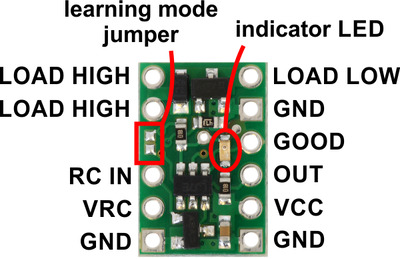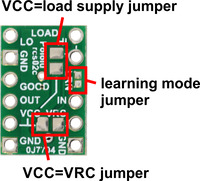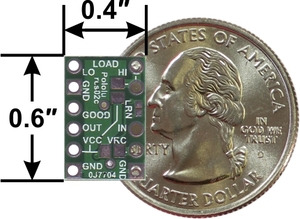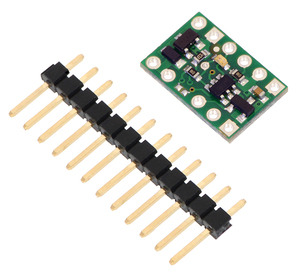Support » Pololu RC Switch User’s Guide » 3. RC Switch with Small Low-Side MOSFET »
3.1. Components of the RC Switch with Small Low-Side MOSFET
 |
Pololu RC Switch with Small Low-Side MOSFET, top labeled view. |
|---|
The Pololu RC Switch with Small Low-Side MOSFET has 11 through holes spaced 0.1″ apart that fit 0.1″ header pins.
RC interface
The GND, VRC, and RC IN pins make up the switch’s RC interface and can be connected directly to an RC receiver or servo controller:
- The GND pin is the ground or reference voltage.
- The VRC pin connects to the RC power line. The power from VRC is not used by default, but a jumper on the bottom of the board can be bridged with solder to power the board from VRC as described below.
- The RC IN pin is the RC signal input. The switch measures the width of pulses on this line and uses that to decide whether to activate or not.
Power
 |
This board involves three potentially-different power supplies:
- VCC: The VCC pin powers the basic functions of the board and needs to be connected to a power source between 2.5 V and 5.5 V. VCC is also the gate voltage that is used to turn the MOSFET on, so it should be noted that lower VCC voltages will lead to higher MOSFET on resistances, which in turn limits the maximum current the device can switch.
- VRC: The VRC pin will generally be connected the power line from your RC system. By default, power from this pin is not used by the board, so this pin is optional.
- LOAD HIGH: The two pins labeled LOAD HIGH will generally be connected to the positive terminal of the load power supply and to the positive terminal of the load.
The bottom of the board has jumpers that can be bridged with solder in order connect VCC to VRC or VCC to LOAD HIGH. These jumpers provide extra flexibility in how the system is powered, and some examples are given in Section 3.2.
Load interface
The LOAD LOW and LOAD HIGH pins are connections for your load and load supply. The LOAD LOW pins are normally disconnected from GND, but when the switch activates the MOSFET turns on and connects LOAD LOW to GND. There is a flyback (also known as a “freewheeling”) diode between LOAD LOW and LOAD HIGH. The board’s MOSFET can deliver up to 3 A with VCC at 5 V and can handle load supply voltages up to 30 V. More details on connecting your load and load supply to the switch can be found in Section 3.2.
Outputs and indicator LED
The RC switch provides feedback about what state it is in via a yellow indicator LED. The LED behavior is described in Section 8. Status information is also provided by two additional outputs:
- The GOOD pin indicates the presence of a valid RC signal (10–330 Hz pulse rate, 0.5–2.5 ms pulse width).
- The OUT pin indicates whether the MOSFET is on.
When these outputs are high they will be at the same voltage level as VCC. When low, these outputs will be at 0 V (ground). These outputs do not have resistors in series with them. Each output can source or sink up to 25 mA.
Configuration interface
The learning mode jumper on both the top and bottom of the board can be used to get the device into learning mode and configure it. The configuration procedure is described in Section 9.
 |
Pololu RC Switch with Small Low-Side MOSFET, bottom view with dimensions. |
|---|
Included hardware
A 12-pin 0.1″ straight breakaway male header is included with the Pololu RC Switch with Small Low-Side MOSFET. The header pins can be soldered in and used to connect the RC switch to perfboards or breadboards.
 |
Pololu RC Switch with Small Low-Side MOSFET with included hardware. |
|---|









